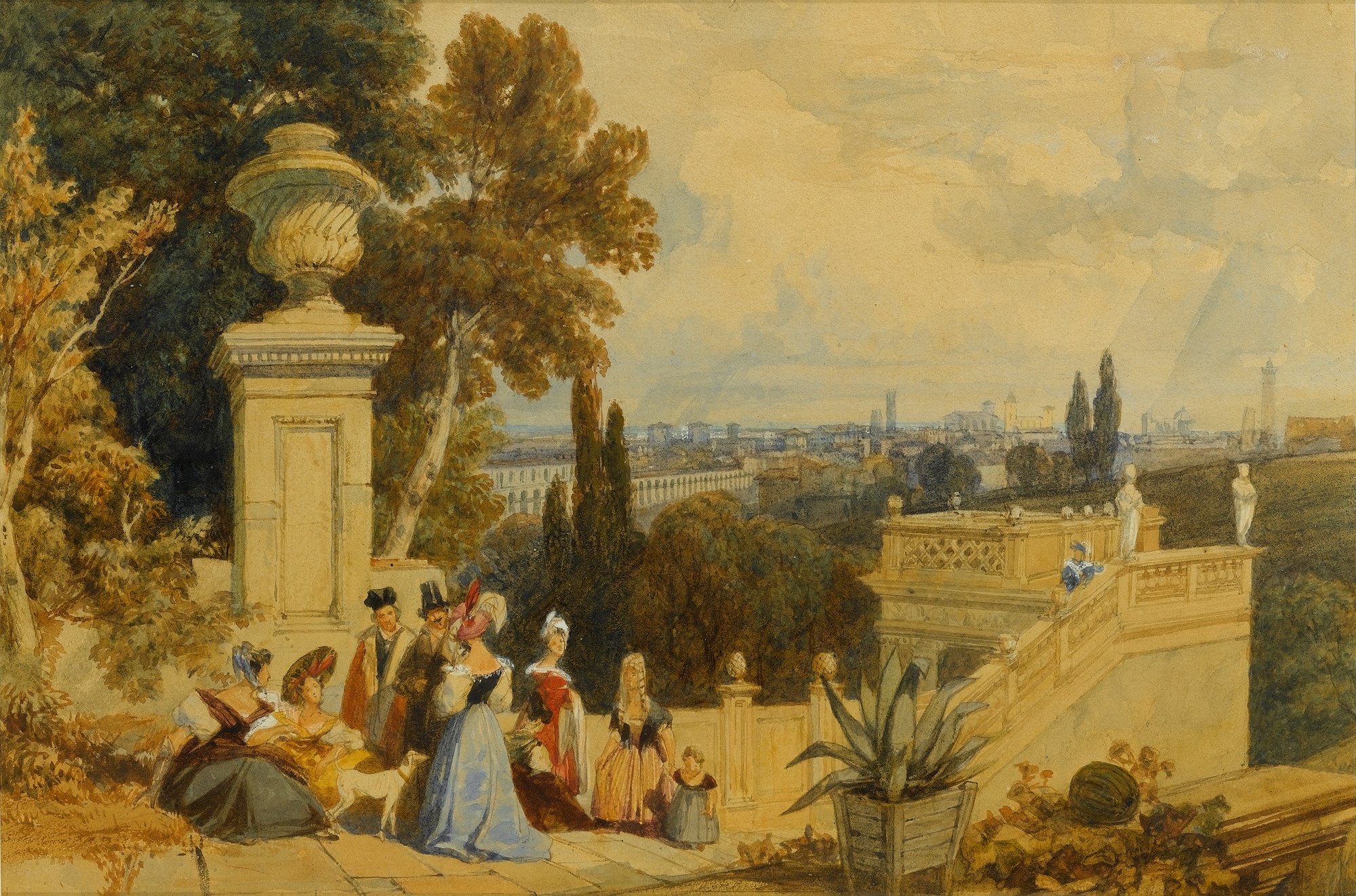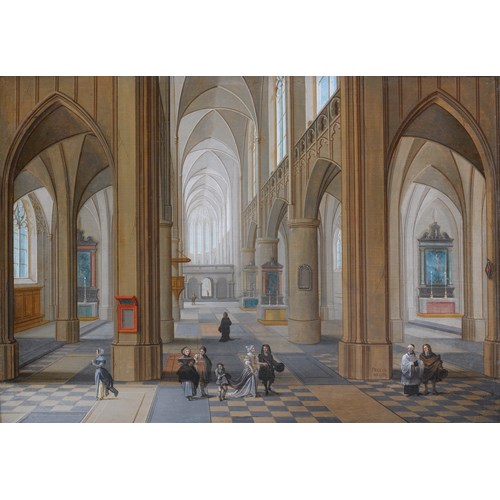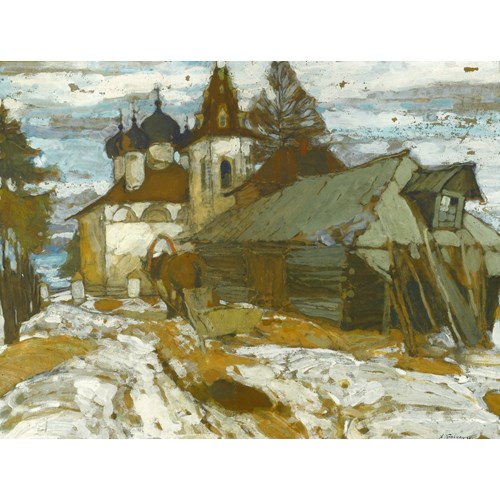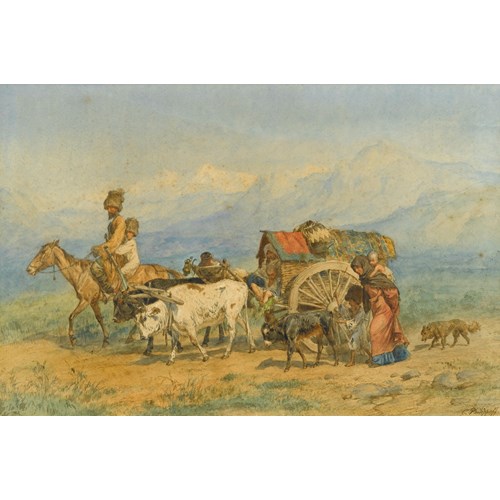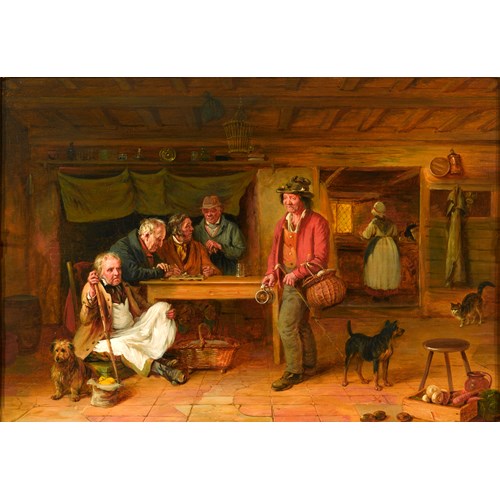Marketplace
Bologna
James Duffield Harding
Bologna
Epoque 1750-1850, 1850-1900, 19th century
Origine England
Medium Watercolour, Pencil, Bodycolour, Gum arabic
Dimension 19.6 x 29.4 cm (7³/₄ x 11⁵/₈ inches)
In this delightful watercolour James Duffield Harding’s has combined the timeless classicism of the city with such a charming theatrical portrayal of human interaction. The result is a truly radiant expression of the Emilia-Romagnan capital. In the foreground, Harding has depicted a group of figures in close interaction with one another. Five ladies, two gentlemen and one dog form a figural arch, the shape of which is loosely guided by the hats and headdress of the individuals. The rich overlap of the ladies’ skirts renders the individual forms more or less indistinguishable, creating a lively visual flow which seems to illustrate the conversation and further unify the group. As the dog looks eagerly beyond the group, the viewer is alerted to the presence of a mother and child dressed in rags at the periphery of the arch, tentatively approaching their well-dressed counterparts.
As the eye is drawn along from this figural interplay to the classical architecture which frames the cityscape, Harding surprises the viewer with the figure of another lady who is leaning over the balustrade contemplating the view below. She is faceless; invisible but for her colourful dress and hat. The faceless form of this lady is cleverly mirrored by her classical companions who stand atop the architecture, their backs to the city; similarly surveying the view below which is inaccessible to the viewer.
The present work was engraved by Edward Finden and published in Finden’s Illustrations of the Life and Works of Lord Byron. These were a series of books in which William Brockedon described various aspects or episodes from the life of Lord Byron (1788-1824) together with accompanying illustrations. The result was a beautiful blend of literature, biography and travel description, as it tours various sites of interest in the life and tales of Byron. The chapter on Bologna, to which the present work accompanied, details an episode from Byron’s visit of 1819, where he was ‘settled like a sausage, and shall be broiled like one, if this weather continues’.¹ Byron describes meeting the groundskeeper of a cemetery, who kept the skull of dead monk, who had been his best friend. After describing this episode Brokedon goes on to give his own thoughts on Bologna as a travel destination.
Harding was a talented watercolourist. Born in 1798, he received his first painting lessons from his father and subsequently was trained in watercolour painting by Samuel Prout (1783-1852). Harding made his first trip to Italy in 1824, with Charles Hullmandel (1789-1850), a visit which would have provided the basis for the present work. Harding made numerous trips to the Continent throughout his lifetime. Harding was acclaimed not only for his watercolours, receiving the Society of Arts medal for an original landscape, but also for his mastery of lithography: he received two gold medals from the Academie des Beaux-Arts for his lithographic plates. He was also largely engaged in teaching, counting John Ruskin amongst his pupils. Ruskin wrote of Harding as being ‘after Turner, unquestionably the greatest master of foliage in Europe’ (see John Ruskin, Modern Painters, I, p. 382). Harding also published several books developing his views of art, including The Tourist in Italy (1831), The Tourist in France (1834), The Park and the Forest (1841), The Principles and the Practice of Art (1845), Elementary Art (1846), Scotland Delineated in a Series of Views (1847) and Lessons on Art (1849).
¹ William Brockedon, Finden’s Illustrations of the Life and Works of Lord Byron, (John Murray, London, 1833) vol. ii.
As the eye is drawn along from this figural interplay to the classical architecture which frames the cityscape, Harding surprises the viewer with the figure of another lady who is leaning over the balustrade contemplating the view below. She is faceless; invisible but for her colourful dress and hat. The faceless form of this lady is cleverly mirrored by her classical companions who stand atop the architecture, their backs to the city; similarly surveying the view below which is inaccessible to the viewer.
The present work was engraved by Edward Finden and published in Finden’s Illustrations of the Life and Works of Lord Byron. These were a series of books in which William Brockedon described various aspects or episodes from the life of Lord Byron (1788-1824) together with accompanying illustrations. The result was a beautiful blend of literature, biography and travel description, as it tours various sites of interest in the life and tales of Byron. The chapter on Bologna, to which the present work accompanied, details an episode from Byron’s visit of 1819, where he was ‘settled like a sausage, and shall be broiled like one, if this weather continues’.¹ Byron describes meeting the groundskeeper of a cemetery, who kept the skull of dead monk, who had been his best friend. After describing this episode Brokedon goes on to give his own thoughts on Bologna as a travel destination.
Harding was a talented watercolourist. Born in 1798, he received his first painting lessons from his father and subsequently was trained in watercolour painting by Samuel Prout (1783-1852). Harding made his first trip to Italy in 1824, with Charles Hullmandel (1789-1850), a visit which would have provided the basis for the present work. Harding made numerous trips to the Continent throughout his lifetime. Harding was acclaimed not only for his watercolours, receiving the Society of Arts medal for an original landscape, but also for his mastery of lithography: he received two gold medals from the Academie des Beaux-Arts for his lithographic plates. He was also largely engaged in teaching, counting John Ruskin amongst his pupils. Ruskin wrote of Harding as being ‘after Turner, unquestionably the greatest master of foliage in Europe’ (see John Ruskin, Modern Painters, I, p. 382). Harding also published several books developing his views of art, including The Tourist in Italy (1831), The Tourist in France (1834), The Park and the Forest (1841), The Principles and the Practice of Art (1845), Elementary Art (1846), Scotland Delineated in a Series of Views (1847) and Lessons on Art (1849).
¹ William Brockedon, Finden’s Illustrations of the Life and Works of Lord Byron, (John Murray, London, 1833) vol. ii.
Epoque: 1750-1850, 1850-1900, 19th century
Origine: England
Medium: Watercolour, Pencil, Bodycolour, Gum arabic
Dimension: 19.6 x 29.4 cm (7³/₄ x 11⁵/₈ inches)
Provenance: Anonymous sale, Sotheby's, London, 16th July 1987, lot 186.
Literature: William Brockedon, Finden’s Illustrations of the Life and Works of Lord Byron, (John Murray, London, 1833) vol. ii.
Engraved:
by Edward Finden.
Plus d'œuvres d'art de la Galerie


